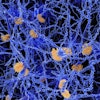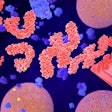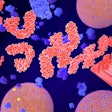
A gene called phosphoglycerate dehydrogenase (PHGDH) looks promising as a biomarker for early Alzheimer's disease (AD) based on a study of RNA blood tests published in the journal Current Biology. The results could open a new avenue of research in blood testing for the disease, beyond beta amyloid and tau, researchers reported.
The group evaluated extracellular RNA (exRNA) in plasma samples from 35 study participants who had confirmed Alzheimer's disease based on postmortem pathological brain examinations and who had been followed for 15 years prior to death. Of the total, nine had not been symptomatic and served as controls.
All of the participants were older than 70. For the liquid biopsy, the researchers applied the small input liquid volume extracellular RNA sequencing (SILVER-seq) technique, which they said enables analysis using only a small droplet -- 5-7 µL -- of blood.
"SILVER-seq's input volume is smaller than a typical drop of blood (30 µL). SILVER-seq has been validated to perform comparably in terms of accuracy and reproducibility to alternative exRNA-seq methods," Koo et al wrote in the report, which was published online March 26.
The results suggest that the overproduction of extracellular RNA and brain protein expression by the PHGDH gene is associated with presymptomatic Alzheimer's disease in older adults and has potential as a future screening tool, noted Dr. Edward Koo, a professor of neuroscience at the University of California, San Diego (UCSD) School of Medicine, and colleagues.
Out of the nine control patients, plasma PHGDH extracellular RNA was increased in eight, even though the patients were stable in terms of their cognitive symptoms over the course of the 15-year follow-up period, the researchers found. Furthermore, the findings were supported by analyses of published datasets, which also showed an association between PHGDH and early Alzheimer's disease, according to the group.
Searching for alternative tests
The study was conducted to address an unmet need for a presymptomatic test for Alzheimer's disease, particularly a noninvasive and affordable method. The field of drug development for the disease has been marred by repeated failures -- yet hope remains that treatments could work if only Alzheimer's was caught early enough.
"Given the prodromal phase of approximately 15 years before onset of clinical symptoms, novel biomarkers of early AD development will greatly assist in providing diagnostic information in presymptomatic individuals," the authors wrote.
Testing of beta amyloid in plasma and tau in cerebrospinal fluid have been exciting advances, but such methods have not exhibited strong power in the presymptomatic phase of disease, the authors noted.
The results suggest that circulating extracellular RNAs "may be a class of overlooked molecules for assessing the expression of genes within the central nervous system," and there may be potential to expand blood biomarker development beyond beta-amyloid and tau proteins and peptides to a "wide range of genes that are activated during AD development," they wrote.
"This expansion is much needed for research of early indications of AD because the initial molecular changes may well predate the accumulation of toxic [beta amyloid] and tau species," Koo et al concluded.



















